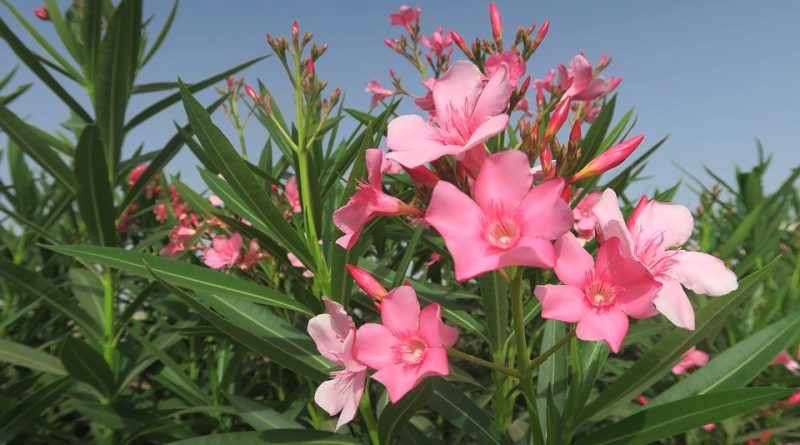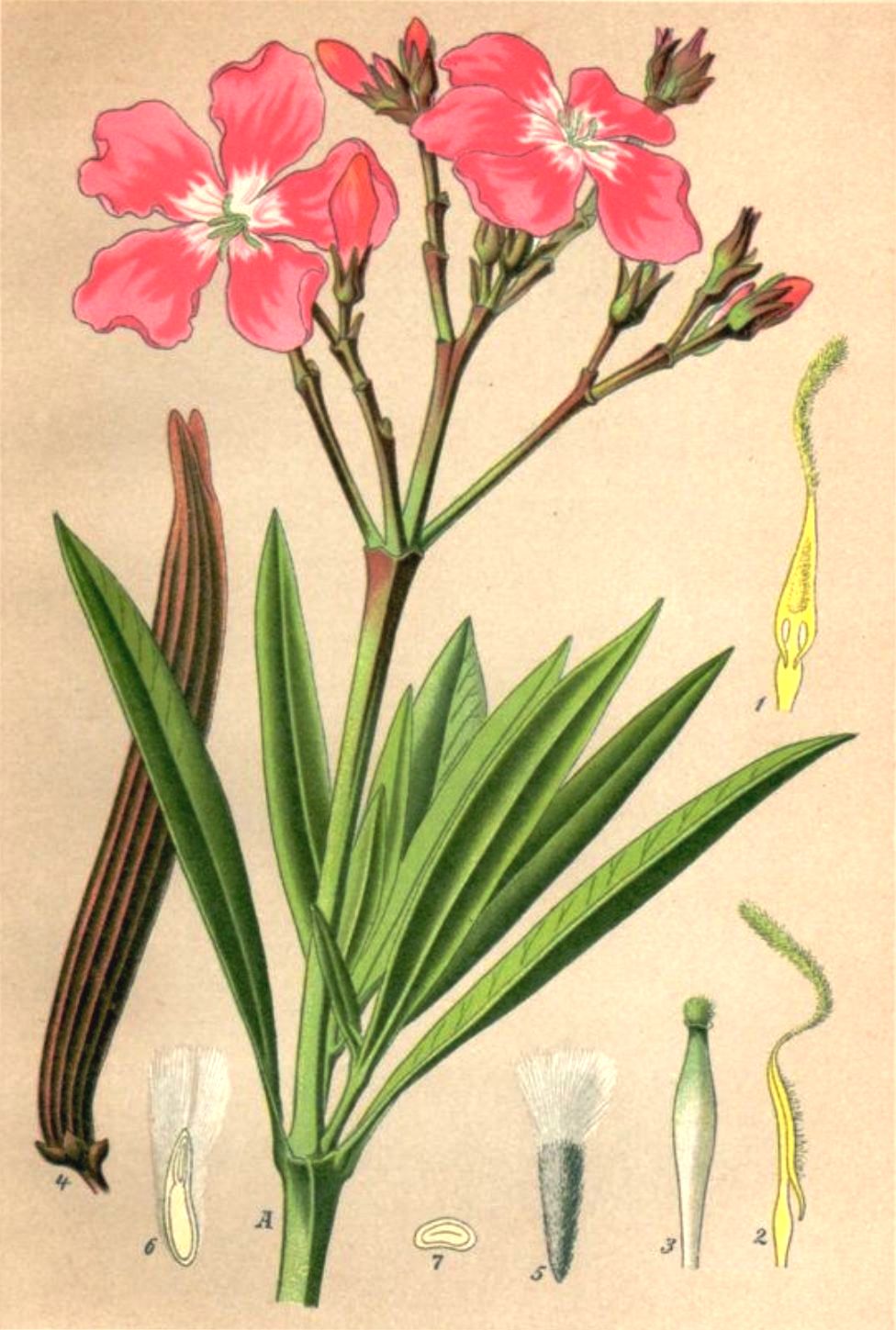Nerium oleander
Nerium oleander
The oleander (Nerium oleander L., 1753) is an evergreen shrub or tree species belonging to the Apocynaceae family.
Systematics –
From the systematic point of view it belongs to the Eukaryota Domain, Kingdom Plantae, Magnoliophyta Division, Magnoliopsida Class, Gentianales Order, Apocynaceae Family, Apocynoideae Subfamily, Nerieae Tribe, Neriinae Sottotribù and therefore to the Genus Nerium and to the Species N. oleander.
Etymology –
The term Nerium comes from the Greek νερόν = νηρός nerón = nerós humid, fresh. The specific epithet oleander is derived from arodándrum, corruption of the Greek ῥοδοδένδρον rhododéndron, term to its cultured from the Greek ῥόδον rhódon rose and from δένδρον déndron tree: for the color of the flowers of many species of this genus.
Geographic Distribution and Habitat –
The Nerium oleander is a species perhaps native to Asia but it is natural and spontaneous in the Mediterranean regions, with an area limited to the Mediterranean coasts, coinciding with that of the Olive tree. The oleander has a fairly large range extending across the warm temperate range from Japan to the Mediterranean basin. In Italy we find it spontaneous in the phytoclimatic area of the Lauretum, both in the coastal areas and up to 1000 meters above sea level especially along the waterways where it often forms a common and unmistakable element of the riparian vegetation of the Mediterranean environments, almost always associated with other riparian species such as alder, tamarisk, agnocast.
Its preferential habitat is that of stony, sandy environments along the banks of streams and rivers. On rock walls, generally of calcareous origin from 0 to 200 m.
Description –
The Nerium oleander, in its spontaneous state, assumes a shrubby habit, with stems that are generally not very branched, starting from the stumps, first erect, then arched outwards. The young branches are green and hairless. The old stems and branches have a grayish bark. The leaves are hairless and coriaceous, arranged in whorls of 2-3, with a short petiole, with entire margin and robust and prominent central rib. The lamina is lanceolate, acute at the apex, 1-2 cm wide and 10-14 cm long. Both the leaves and the stem are poisonous.
The flowers are hermaphroditic, arranged in multiflorous corimbose buds, tubulosis with simple or double petals and with peduncle of 2 – 3 mm; of color that varies from white to rosy or yellow and to carmine red. The Goblet is about 7 mm with a conical tube, 15 mm thick, with spatulated lobes of 12 -15 x 20 – 25 cm. The ovary is bilocular with 2 welded carpels, and with numerous ova.
The fruit is an elongated fusiform follicle of brown color, of 1 x 10 -15 cm, which at maturity opens up spreading densely hairy seeds with brownish pappi. The antesis takes place between May and July.
Cultivation –
For the cultivation of the oleander it should be taken into account that it is a very resistant evergreen shrub and for this reason it is cultivated in a massive way in urban environments. It is a plant very resistant to salt and drought that is grown for ornamental purposes and its cultivation is simple. The oleander fears the cold, it thrives well in its phytoclimatic zone that provides temperate places, sunny and sheltered from the cold. In its natural state it can not withstand temperatures below -5, -7 degrees Celsius. It is a highly polloniferous species. For its cultivation technique, the following sheet can be consulted.
Uses and Traditions –
The Nerium oleander is the only species of the genus Nerium and is one of the most toxic plants known. The whole plant (leaves, bark, seeds) is toxic for any animal species. If swallowed it leads to: bradycardia and increased respiration rate, gastric disorders, including vomiting, nausea and burning, disturbances on the central nervous system, including drowsiness.
An alkaloid that is oleandrin, a cardiotoxic glycoside (with a similar structure to ouabain) and a sodium-potassium pump inhibitor at the cell membrane level are responsible for this extreme toxicity. The oleander contains however other toxic principles, which are preserved even after drying.
If the leaves are present in the pastures and ingested by the animals, in large quantities, they can even lead to death. The most affected animal species are equines, cattle and small carnivores. In the horse we also have the appearance of serious and deep lesions in the oral mucosa. Death comes by cardio-respiratory collapse.
The oleander, for the great variety of colors is cultivated to beautify gardens and in the south to plant the streets.
Perhaps because of its toxicity, since ancient times the oleander was known as a funerary plant. Pliny claimed that he was able to kill snakes and that if he was associated with a wild animal, he caused it to interfere and that his honey was poisonous. Apuleius narrates, in his “Metamorphoses” that Lucio was transformed into a donkey and while he was looking for the roses that had to give him the human form, he was deceived by the flowers of oleander but before he bit into it he noticed his danger.
Because of its toxic properties, in the countryside of some Italian regions, the plant is called “horse killing” or “ass kill”.
It is said that its fried stems were the deadly cause among Napoleon’s soldiers who used them for roasters: the fire distilled its glycosides that mixed with the meat causing poisoning. Furthermore its toxic properties have been used as a “weapon” for the murder described in the film White Oleander.
Preparation Mode –
Because of its toxic properties, the Nerium oleander does not find any application in the kitchen while some active ingredients can be used in homeopathy or phytotherapy for diseases related to heart failure.
Guido Bissanti
Sources
– Acta Plantarum – Flora of the Italian Regions.
– Wikipedia, the free encyclopedia.
– Treben M., 2000. Health from the Pharmacy of the Lord, Advice and experience with medicinal herbs, Ennsthaler Publisher
– Pignatti S., 1982. Flora of Italy, Edagricole, Bologna.
– Conti F., Abbate G., Alessandrini A., Blasi C. (edited by), 2005. An annotated checklist of the Italian vascular flora, Palombi Editore.
Attention: Pharmaceutical applications and alimurgical uses are indicated for informational purposes only, they do not in any way represent a medical prescription; there is therefore no liability for their use for curative, aesthetic or food purposes.


